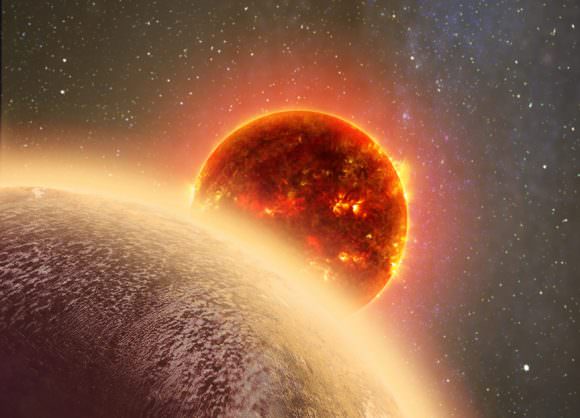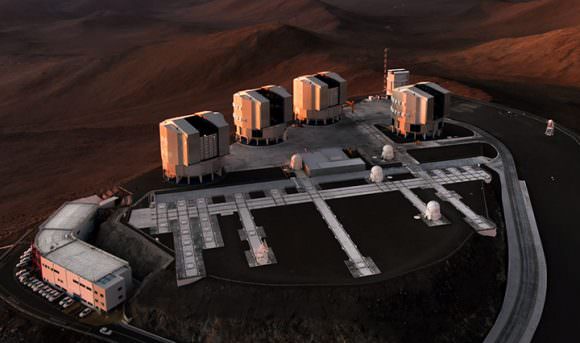x


| Online: | |
| Visits: | |
| Stories: |

| Story Views | |
| Now: | |
| Last Hour: | |
| Last 24 Hours: | |
| Total: | |
Finally! A Low Mass Super-Earth With Some Funky Atmosphere
In 2015, astronomers discovered an intriguing extrasolar planet located in a star system some 39 light years from Earth. Despite orbiting very close to its parent star, this “Venus-like” planet – known as GJ 1138b – appeared to still be cool enough to have an atmosphere. In short order, a debate ensued as to what kind of atmosphere it might have, whether it was a “dry Venus” or a “wet Venus”.
And now, thanks to the efforts of an international team of researchers, the existence of an atmosphere has been confirmed around GJ 1138b. In addition to settling the debate about the nature of this planet, it also marks the first time that an atmosphere has been detected around a low-mass Super-Earth. On top of that, GJ 1138b is now the farthest Earth-like planet that is known to have an atmosphere.
Led by John Southworth (of Keele University) and Luigi Mancini (of the University of Rome Tor Vergata), the research team included members from the Max Planck Institute for Astronomy (MPIA), the National Institute for Astrophysics (INAF), the University of Cambridge and Stockholm University. Their study, titled “Detection of the atmosphere of the 1.6 Earth mass exoplanet GJ 1132b“, recently appeared in The Astrophysical Journal.
Using the GROND imager on the La Silla Observatory’s 2.2m ESO/MPG telescope, the team monitored GJ 1132b in seven different wavelength bands as it transited in front of its parent star. Given the planet’s orbital period (1.6 days), these transits happen quite often, which presented plenty of opportunities to examine how it absorbs light from its sun.
In so doing, the team monitored the slight decreases in the star’s brightness that were due to its atmosphere absorbing some of the star’s light. Looking closely, they found that the planet appeared larger in the infrared wavelength than in others. From this, they deduced the presence of an atmosphere which appears opaque in infrared light (creating the illusion of it being larger) but which is transparent at all other wavelengths.
The team members from the University of Cambridge and the MPIA then conducted simulations to see what this atmosphere’s composition could be. Ultimately, they concluded that it most likely has an atmosphere that is rich in water and methane – which contradicted earlier theories that the planet had a thin and tenuous atmosphere (i.e. a “dry Venus”).
It was also the first time that an atmosphere has been confirmed around a planet that is not significantly greater in size and mass to Earth. In the past, astronomers have detected atmospheres around many other exoplanets. But in these cases, the planets were either gas giants or planets that were many times Earth’s size and mass (aka. “Super-Earths”). GJ 1132b, however, is 1.6 times as massive as Earth, and measures 1.4 Earth radii.
In addition, these findings are a significant step in the search for life beyond our Solar System. At present, astronomers seek to determine the chemical composition of a planet’s atmosphere to determine if it could be habitable. Where the right combination of chemical imbalances exist, the presence of living organisms is seen as a possible cause.
By being able to determine that a planet at lower end of the super-Earth scale has an atmosphere, we are one step closer to being able to determine exoplanet habitability. The detection of an atmosphere-bearing planet around an M-type (red dwarf) star is also good news in and of itself. In recent years, astronomers have detected several terrestrial planets orbiting nearby red dwarfs – including seven around a single star (TRAPPIST-1).
Recent studies have also shown that red dwarfs are not only very common in the known Universe, but they are also capable of hosting large numbers of planets. However, there have been long-standing concerns that red dwarfs are too variable and unstable for their planet’s to be habitable. Due to the commonality of flare ups and particle streams, it would be difficult for any planets orbiting them to retain their atmospheres.
As such, finding a planet that is both comparable in size to Earth and has an atmosphere is highly encouraging. In the future, GJ 1132b is expected to be a high-priority target for study with the Hubble Space Telescope, the Very Large Telescope (VLT) at the Paranal Observatory in Chile, and next-generation telescopes like the James Webb Space Telescope (scheduled for launch in 2018).
I’m sure I’m not the only one who is eager to hear about what they discover when they set their sights on this nearby star system and it’s Venus-like world! In the meantime, be sure to check out this video about GJ 1132b, courtesy of MIT news:
Further Reading: Max Planck Institute for Astronomy
The post Finally! A Low Mass Super-Earth With Some Funky Atmosphere appeared first on Universe Today.
Source: https://www.universetoday.com/134939/finally-low-mass-super-earth-funky-atmosphere/

This fountain has been turned off.
Please check again later



